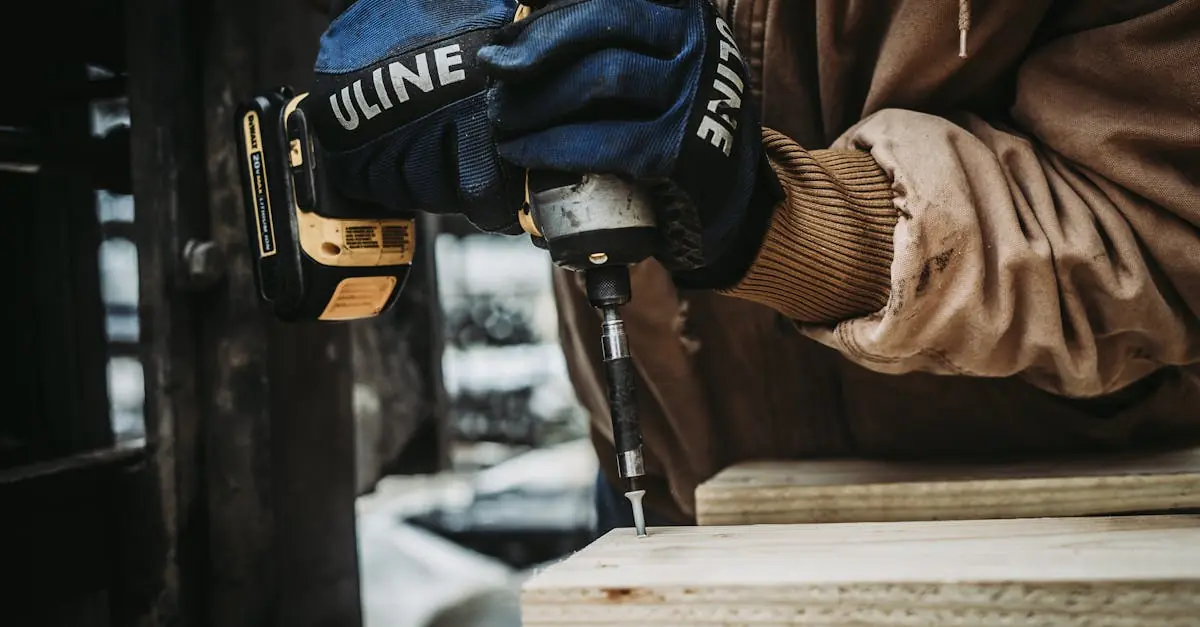Woodworking might sound intimidating, but it’s time to grab that saw and unleash the inner craftsman. DIY wood projects for beginners offer a perfect blend of creativity and satisfaction, and let’s be honest—who wouldn’t want to impress friends with a handmade masterpiece? Imagine the look on their faces when they discover that the stunning coffee table or rustic bookshelf didn’t come from a store but from your very own hands.
Table of Contents
ToggleOverview of DIY Wood Projects
DIY wood projects offer endless possibilities for creativity and craftsmanship. Beginners often start with simple projects, allowing them to build confidence and skills. Items like picture frames or birdhouses serve as excellent starting points, as they require minimal materials and tools.
Once comfortable with basic techniques, individuals can progress to more complex creations, such as shelves or tables. Making these items not only enhances woodworking abilities but also results in functional pieces for the home. Many beginners find great satisfaction in customizing their projects, using various stains and finishes to match personal style.
In addition to learning techniques, beginners gain valuable tools for future projects. Essential tools include a saw, drill, and sander. Understanding how to use these tools safely and effectively is crucial for success. Following step-by-step instructions available online or in DIY books helps streamline the learning process.
Joining local woodworking communities or online forums provides additional support. These resources connect beginners with experienced artisans who share tips, resource recommendations, and troubleshooting advice. Engaging with others fosters a sense of community and encourages sustained interest in woodworking.
Completing DIY wood projects yields unique results that enhance home decor and can even serve as thoughtful gifts. Individuals impress friends and family with handmade items, showcasing creativity and personal touch. The fulfillment derived from seeing a finished project reflects the joy and sense of accomplishment inherent in woodworking.
Essential Tools and Materials
Having the right tools and materials is crucial for successfully completing DIY wood projects. Beginners benefit significantly from understanding what’s essential for their woodworking journey.
Must-Have Tools for Beginners
Essential tools for beginners include a circular saw, drill, and a sander. Measuring tape and square make precise cuts easier to achieve. Clamps hold pieces securely, ensuring stability during assembly. Safety glasses protect eyes while working, and ear protection minimizes noise exposure. A workbench provides a dedicated space for projects, enhancing efficiency. Investing in these tools sets the foundation for successful woodworking experiences.
Recommended Wood Types
Softwoods like pine and cedar suit beginners well due to their workability and affordability. Birch offers durability and a fine grain, making it ideal for furniture. Plywood provides versatility and strength for various projects. Hardwoods like oak and maple, while more expensive, deliver lasting quality for advanced creations. Each wood type offers unique characteristics, allowing for personalized choices in project design. Selecting appropriate materials facilitates smooth crafting for beginner woodworkers.
Simple DIY Wood Projects
Beginners can start their woodworking journey with simple yet rewarding projects that enhance skills and boost confidence. Two ideal starting projects include a wooden planter box and a bookshelf.
Project 1: Wooden Planter Box
Creating a wooden planter box is straightforward and offers creativity. Use untreated cedar or pine, as these materials resist moisture and decay. Begin by cutting four pieces of wood: two long sides and two short sides. Join the pieces using wood screws, ensuring a sturdy frame. A drill makes this task easy. Sand the edges for a smooth finish, then apply an appropriate wood sealant for moisture protection. Insert a plastic liner to prevent water from seeping through. This project adds a touch of greenery to any space and showcases craftsmanship.
Project 2: Bookshelf
Building a bookshelf can transform a room while offering practical storage. Select pine or plywood for cost-effective and manageable materials. Measure the desired height and width for the bookshelf, then cut two vertical pieces for the sides and several horizontal pieces for the shelves. Space the shelves according to the intended use, securing them with screws for stability. After assembly, sand the edges and surfaces for a polished look. Finishing with a stain or paint can personalize the bookshelf, aligning it with existing decor. This project merges functionality with aesthetics, making it a perfect choice for beginners.
Tips for Successful DIY Woodworking
Successful DIY woodworking demands attention to detail and adherence to best practices. Prioritizing safety ensures a productive crafting experience.
Safety Precautions
Safety precautions form the foundation of any woodworking project. Always wear safety glasses to protect the eyes from flying debris. Using a dust mask can safeguard against inhaling sawdust. Keep fingers clear of saw blades, and employ push sticks when working with table saws to maintain a safe distance. Having a first aid kit nearby offers a sense of security during unforeseen accidents. Ensure the workspace is well-lit, as it aids in accurate measurements and visibility. Finally, proper training on tool usage prevents injuries and enhances overall confidence while working.
Measuring and Cutting Techniques
Measuring and cutting techniques significantly influence the quality of woodworking projects. First, use a measuring tape for precise dimensions; this minimizes mistakes. A square tool ensures straight cuts, particularly when cutting corners or joining pieces. Mark cutting lines with a pencil, making them easy to follow. When utilizing circular or miter saws, maintain steady pressure for clean and accurate cuts. Practicing on scrap wood helps refine skills before tackling valuable materials. Consistently double-checking measurements encourages accuracy, eliminating waste and frustration in the crafting process. Embrace these techniques to enhance woodworking outcomes and boost confidence.
Resources for Learning More
Online platforms offer a wealth of information for beginners in woodworking. Websites like Instructables and YouTube feature countless tutorials and step-by-step guides tailored for various skill levels. These resources simplify complex techniques, helping individuals grasp essential concepts quickly.
Books provide another excellent source of knowledge. Titles focused on beginner woodworking cover topics from tool usage to project planning. Authors often share tips based on personal experience, making them invaluable for those just starting.
Forums and social media groups can enhance learning through community support. Engaging with experienced woodworkers allows beginners to ask questions and receive feedback on their projects. This interaction fosters a collaborative environment, encouraging skill development.
Local workshops present hands-on learning opportunities. Many community centers and stores offer scheduled classes. These sessions often cover fundamental techniques and materials, creating a solid foundation for future projects.
Additionally, podcasts dedicated to woodworking inspire and educate with expert insights. Listening to experienced artisans share their journeys provides motivation and practical tips for beginners. These audio resources are convenient for anyone interested in learning while multitasking.
Accessing various resources enriches the woodworking experience. By exploring online courses, reading books, participating in community discussions, attending workshops, and listening to podcasts, newcomers can develop their skills and deepen their understanding of woodworking. Each avenue offers unique benefits, creating a comprehensive learning experience.
DIY wood projects offer beginners a unique opportunity to unleash their creativity while honing valuable skills. By starting with simple projects and gradually progressing to more complex ones, they can build confidence and enjoy the satisfaction of creating functional home decor.
With the right tools and safety measures in place, anyone can embark on this rewarding journey. The wealth of resources available online and in local communities provides ample support for newcomers. As they explore the world of woodworking, they’ll not only produce beautiful handmade items but also experience a profound sense of accomplishment. Embracing this craft can lead to lasting enjoyment and personal growth.




